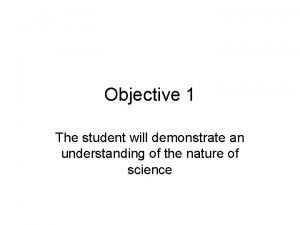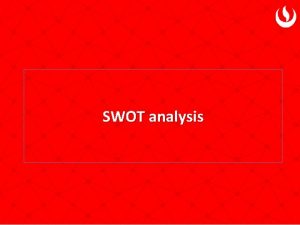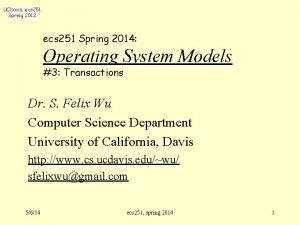ECS 1501 Learning Unit 4 Learning Outcomes Once










- Slides: 10

ECS 1501 Learning Unit 4

Learning Outcomes Once you have studied this chapter you should be able to explain what economics is all about: • Understand the interaction between households and firms • Explain demand supply with words and with a graph • Define the law of demand • Explain the difference between demand quantity demanded • Explain the difference between supply and quantity supplied • Show the shift of the demand or supply curves and a movement of along the curves. • Identify determinant of demand supply.

4. 1 Demand supply: . Read pg. 60 in your textbook An introduction • We focus on the goods market, the market where firms are suppliers, and households are consumers who demand goods and services • In the market economy prices and quantities traded in the goods markets are determined by the interaction of demand supply

The interaction between households and firms Rent, wages, salaries, interest and profit paid to households Firms Natural resources, labour, capital and entrepreneurship sold to firms Supply goods and services Households Demand for goods and services Goods market

4. 2 Demand Read pg. 61 – 68 in your textbook • Demand is the outcome of decisions about which wants to satisfy, given the available means • Sally’s demand for coffee means she intends to buy the coffee and has the means to do so. • Demand refers to the quantity of coffee that Sally is willing and able to buy • Demands are NOT wants. Wants are unlimited desires that people have • Demand is only effective when a consumer is willing and able to buy • Demands are NOT needs or claims either

The demand function

Price of Coffee The lower the price of coffee, the larger the quantities of coffee that Sally would want to buy. Tastes or preferences The more Sally enjoys coffee, the more she will consume and hence buy. However, Sally may not like coffee and only purchase it for her visitors. She will then consume less coffee. Individual Demand What will determine the quantities of coffee Sally plans to buy? Size of the household If Sally lives alone she will buy less coffee than if she was living with someone who also enjoys consuming coffee Prices of related products Complements – goods that are used jointly. Sugar and milk are complements as they are used in the process of preparing a cup of coffee Substitutes – Goods that can be used instead. Tea is a substitute as Sally can drink tea if she cannot afford coffee Income Sally’s decision will be influenced by her income. The higher income, the more coffee she will be able to afford

For introductory purposes we make the ceteris paribus assumption meaning that all other variables are assumed to be constant except the price of the product. Hence the quantity demanded becomes a function of the price Therefore, the Law of Demand states: All other things being equal (ceteris paribus), the higher the price of a good, the lower the quantity demanded will be.

The Law of Demand • The law of demand states that there is a negative/ inverse relationship between the price of a product and the quantity demanded • A negative relationship can be identified by one variable increasing while another variable decreases, a positive relationship can be identified by both variables increasing or both variable decreasing at the same time.

Sally’s demand for coffee tins Price of coffee Quantities of coffee demanded R 10 100 R 20 80 R 30 60 R 40 40 R 50 20 R 60 0 Sally’s demand for coffee tins is a clear reflection of the law of demand. As the price of coffee increases, Sally’s quantity demanded for coffee decreases. Sally’s demand can be presented graphically by putting the Price of coffee on the y-axis and the quantity demanded on the x-axis. This will create a demand curve



















